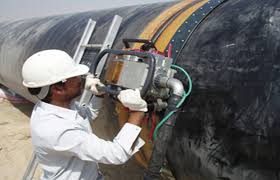Non‑Destructive Testing for Construction in Egypt: Ensuring Structural Integrity Non‑destructive testing for construction in Egypt plays a critical role in ensuring the structural integrity and safety of buildings and infrastructure projects. With a rapidly growing construction industry in Egypt, the need for reliable and effective non‑destructive testing methods has become ut weld inspection increasingly important. These methods allow for the evaluation of the quality and reliability of construction materials and components without causing any damage to the structure. In this article, we will explore the significance of non‑destructive testing for construction in Egypt and its impact on ensuring the safety and longevity of built environment.
Non-destructive testing (NDT) plays a crucial role in ensuring the structural integrity of construction projects in Egypt. By using various testing methods such as ultrasonic testing, radiography, and magnetic particle testing, construction professionals can identify potential defects or weaknesses in materials and structural components without causing any damage. In Egypt, NDT is particularly important for large-scale construction projects such as infrastructure developments, commercial buildings, and residential complexes. This is because ensuring the safety and durability of these structures is paramount for public welfare and economic growth. By conducting thorough NDT inspections, construction companies in Egypt can detect any flaws in materials or construction techniques, allowing them to make necessary adjustments and repairs before potential issues arise. This ultimately leads to safer, longer-lasting structures that comply with industry standards and regulations. Furthermore, NDT helps to minimize the risks of structural failures, which can be costly and dangerous for both construction companies and the public. By implementing NDT practices into construction projects, Egypt can improve the overall quality and reliability of its built environment. In conclusion, non-destructive testing is a vital component of construction in Egypt, as it ensures the structural integrity of buildings and infrastructure projects. ultrasonic non destructive testing By utilizing NDT techniques, construction professionals can identify and address potential issues, ultimately leading to safer and more durable structures for the benefit of the country and its citizens.
Advantages of Non-Destructive Testing in Egyptian Construction Projects

Non-destructive testing offers several advantages in Egyptian construction projects. First, it allows for thorough inspection of materials and structures without causing any damage, saving time and costs associated with repairs. Additionally, non-destructive testing provides reliable data for quality control and ensures the safety and structural integrity of buildings and infrastructure. This approach also helps in identifying potential defects and abnormalities, preventing costly failures in the non destructive testing companies future. Furthermore, it complies with international construction standards and regulations, enhancing the overall quality and longevity of construction projects in Egypt.
Non-Destructive Testing Techniques for Quality Assurance in Egyptian Construction
ut weld inspection

Non-destructive testing (NDT) techniques are widely utilized in the Egyptian construction industry for quality assurance purposes. These techniques are used to evaluate the properties and integrity of construction materials and components without causing damage to the structure being tested. Common NDT methods employed in Egyptian construction projects include visual inspection, ultrasonic testing, radiographic testing, magnetic particle testing, and liquid penetrant testing. These techniques help to identify defects, discontinuities, and weaknesses in materials, ensuring the durability and safety of the structures. NDT plays a crucial role in maintaining the quality and reliability of construction projects in Egypt, ultimately contributing to the overall safety and longevity of the built environment.
The Role of Non-Destructive Testing in Ensuring Structural Integrity in Egypt

Non-destructive testing (NDT) plays a crucial role in ensuring the structural integrity of buildings and infrastructure in Egypt. With a growing population and rapid urban expansion, the demand for safe and reliable structures is higher than ever. NDT techniques such as ultrasonic testing, radiography, and eddy current testing are used to assess the quality of materials, detect defects, and monitor the condition of structures without causing any damage. This is especially important in Egypt, where historical and ancient structures coexist with modern ones, requiring a careful balance of preservation and modernization. Additionally, NDT helps comply with regulations and standards, enhances safety, and minimizes the risk of structural failures, ultimately contributing to the long-term sustainability and resilience of Egypt's infrastructure.
Innovative Non-Destructive Testing Methods for Construction in Egypt<
ut weld inspection/h2>
Innovative non-destructive testing methods for construction in Egypt include techniques such as ground-penetrating radar (GPR), ultrasonic pulse velocity testing, and thermography. These methods allow for the inspection of structures and materials without causing damage, providing valuable information about the integrity and safety of buildings and infrastructure. GPR is used to locate underground utilities and assess concrete structures, while ultrasonic pulse velocity testing measures the speed of sound waves through concrete to detect flaws or deterioration. Thermography uses infrared cameras to detect variations in temperature that can indicate hidden defects or moisture in building materials. These advanced testing methods are essential for ensuring the quality and durability of construction projects in Egypt.
Challenges and Opportunities of Non-Destructive Testing in Egyptian Construction
Challenges in non-destructive testing in the Egyptian construction industry include limited awareness and acceptance of NDT techniques among construction professionals, a shortage of skilled NDT technicians, and the need for investment in advanced NDT equipment. Opportunities in this field include the potential for improved construction quality and safety, cost savings through early detection of defects, and compliance with international standards for construction projects in Egypt. Additionally, there is an opportunity for NDT companies to expand their services and train new technicians to meet the growing demand for non-destructive testing in the construction sector.
Implementing Non-Destructive Testing for Sustainable Construction in Egypt
Non-destructive testing (NDT) is a crucial tool for ensuring the quality and safety of construction projects in Egypt. By utilizing NDT methods such as ultrasonic testing, radiography, and electromagnetic testing, construction professionals can identify any flaws or defects in materials and structures without causing damage. This not only helps to prevent costly rework and repairs but also enhances the long-term sustainability of construction projects by ensuring structural integrity and safety. In Egypt, the implementation of NDT for sustainable construction has the potential to improve the overall quality of buildings and infrastructure, leading to greater resilience against natural disasters and structural failure. Additionally, NDT can help to optimize material usage, reduce construction waste, and minimize environmental impact, aligning with the country's goals for sustainable development. By investing in NDT training, certification, and equipment, the construction industry in Egypt can enhance its capabilities and competitiveness, leading to better-built and more sustainable structures for the future. Furthermore, the adoption of NDT practices can contribute to the overall advancement of the construction sector in Egypt, positioning it as a leader in sustainable building practices within the region.
Future Trends in Non-Destructive Testing for Egyptian Construction Industry
The Egyptian construction industry is expected to see a surge in the use of advanced non-destructive testing (NDT) methods in the coming years. This is primarily driven by the need for ensuring the safety and reliability of structures while also maintaining cost-efficiency in construction projects. One key trend is the adoption of automated NDT technologies, such as robotics and drones, for conducting inspections in hard-to-reach or hazardous areas. These technologies can provide real-time data and imagery, allowing for more accurate and comprehensive assessments of structural integrity. Another trend is the increased use of enhanced imaging techniques, such as advanced ultrasonic testing and digital radiography, which offer higher resolution and sensitivity in detecting potential defects and anomalies in construction materials. Furthermore, the integration of artificial intelligence and machine learning algorithms into NDT processes is expected to improve the analysis and interpretation of inspection data, leading to more precise and reliable assessment of structural conditions. Overall, the future of NDT in the Egyptian construction industry is expected to be characterized by the adoption of innovative technologies that offer greater efficiency, accuracy, and safety in assessing the quality and integrity of construction projects.